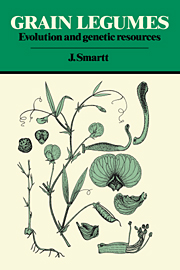Book contents
- Frontmatter
- Contents
- Preface
- Acknowledgements
- 1 Introduction: biosystematics of the legumes
- 2 The role of grain legumes in the human economy
- 3 The groundnut, Arachis hypogaea L.
- 4 The New World pulses: Phaseolus species
- 5 The Old World pulses: Vigna species
- 6 Pulses of the classical world
- 7 The other legume oilseeds
- 8 The pigeonpea (Cajanus cajan (L.) Millsp.)
- 9 Minor grain legumes
- 10 Germplasm resources and the future
- References
- Postscript
- Supplementary references
- Author index
- General index
8 - The pigeonpea (Cajanus cajan (L.) Millsp.)
Published online by Cambridge University Press: 11 September 2009
- Frontmatter
- Contents
- Preface
- Acknowledgements
- 1 Introduction: biosystematics of the legumes
- 2 The role of grain legumes in the human economy
- 3 The groundnut, Arachis hypogaea L.
- 4 The New World pulses: Phaseolus species
- 5 The Old World pulses: Vigna species
- 6 Pulses of the classical world
- 7 The other legume oilseeds
- 8 The pigeonpea (Cajanus cajan (L.) Millsp.)
- 9 Minor grain legumes
- 10 Germplasm resources and the future
- References
- Postscript
- Supplementary references
- Author index
- General index
Summary
The pigeonpea can justifiably be regarded as an under-exploited legume; the reasons why this should be so are not entirely clear. The most likely explanation is that there is an acceptability problem in some parts of the world. Curiously, in the United Kingdom the pigeon pea has been consumed in small quantity, but consistently, as yellow split peas for making pease-pudding. The problem of limited acceptance is one which could at the present time be overcome by judicious stimulation of demand. Present dietary recommendations favour increased consumption of pulses by way of an alternative to red meat as a protein source (avoiding excessive intake of saturated fat) and as a source of dietary fibre. There is also a possible role as a protein source for the manufacture of textured vegetable protein for use in meat substitutes, meat extenders and the like.
The major centre of world production is undoubtedly India, where it is the second most important pulse crop. Production is about 2 million tonnes annually world wide, of which a little less than 85% is produced in India. Potential yield levels in excess of 2 t ha–1 are indicated from trials at ICRISAT (Annual Report, 1982) while in Queensland some breeding lines have indicated yields of over 41 ha–1.
Classification and biosystematics
Taxonomy
The pigeonpea is a member of the sub-tribe Cajaninae of the Phaseoleae and it is the only member of its sub-tribe to have been domesticated. The taxonomy of Cajanus DC.
- Type
- Chapter
- Information
- Grain LegumesEvolution and Genetic Resources, pp. 278 - 293Publisher: Cambridge University PressPrint publication year: 1990
- 5
- Cited by

